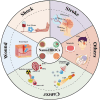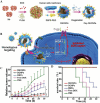Nanomaterial-related hemoglobin-based oxygen carriers, with emphasis on liposome and nano-capsules, for biomedical applications: current status and future perspectives
- PMID: 38880905
- PMCID: PMC11180412
- DOI: 10.1186/s12951-024-02606-1
Nanomaterial-related hemoglobin-based oxygen carriers, with emphasis on liposome and nano-capsules, for biomedical applications: current status and future perspectives
Abstract
Oxygen is necessary for life and plays a key pivotal in maintaining normal physiological functions and treat of diseases. Hemoglobin-based oxygen carriers (HBOCs) have been studied and developed as a replacement for red blood cells (RBCs) in oxygen transport due to their similar oxygen-carrying capacities. However, applications of HBOCs are hindered by vasoactivity, oxidative toxicity, and a relatively short circulatory half-life. With advancements in nanotechnology, Hb encapsulation, absorption, bioconjugation, entrapment, and attachment to nanomaterials have been used to prepare nanomaterial-related HBOCs to address these challenges and pend their application in several biomedical and therapeutic contexts. This review focuses on the progress of this class of nanomaterial-related HBOCs in the fields of hemorrhagic shock, ischemic stroke, cancer, and wound healing, and speculates on future research directions. The advancements in nanomaterial-related HBOCs are expected to lead significant breakthroughs in blood substitutes, enabling their widespread use in the treatment of clinical diseases.
Keywords: Cancer; Hemoglobin-based oxygen carriers (HBOCs); Hemorrhagic shock; Nanomaterials; Oxygen transport.
© 2024. The Author(s).
Conflict of interest statement
The authors declare that they have no competing interests.
Figures







Similar articles
-
Recent and prominent examples of nano- and microarchitectures as hemoglobin-based oxygen carriers.Adv Colloid Interface Sci. 2018 Oct;260:65-84. doi: 10.1016/j.cis.2018.08.006. Epub 2018 Aug 24. Adv Colloid Interface Sci. 2018. PMID: 30177214 Review.
-
Insights from studies of blood substitutes in trauma.Shock. 2005 Sep;24(3):197-205. doi: 10.1097/01.shk.0000180075.76766.fe. Shock. 2005. PMID: 16135956 Review.
-
Review of hemoglobin-vesicles as artificial oxygen carriers.Artif Organs. 2009 Feb;33(2):139-45. doi: 10.1111/j.1525-1594.2008.00698.x. Artif Organs. 2009. PMID: 19178458 Review.
-
Numerical simulation of oxygen delivery to muscle tissue in the presence of hemoglobin-based oxygen carriers.Biotechnol Prog. 2006 Jul-Aug;22(4):1025-49. doi: 10.1021/bp060022a. Biotechnol Prog. 2006. PMID: 16889379
-
Cerebral oxygen delivery by liposome-encapsulated hemoglobin: a positron-emission tomographic evaluation in a rat model of hemorrhagic shock.J Appl Physiol (1985). 2007 Jul;103(1):28-38. doi: 10.1152/japplphysiol.00136.2006. J Appl Physiol (1985). 2007. PMID: 17615284
Cited by
-
Artificial blood-hope and the challenges to combat tumor hypoxia for anti-cancer therapy.Med Biol Eng Comput. 2025 Apr;63(4):933-957. doi: 10.1007/s11517-024-03233-6. Epub 2024 Nov 30. Med Biol Eng Comput. 2025. PMID: 39614063 Review.
-
Stimuli-responsive nanozymes for wound healing: From design strategies to therapeutic advances.Mater Today Bio. 2025 Jul 2;33:102046. doi: 10.1016/j.mtbio.2025.102046. eCollection 2025 Aug. Mater Today Bio. 2025. PMID: 40688673 Free PMC article. Review.
-
Advanced delivery systems for oxygen therapeutics: center around red blood cells.Ther Deliv. 2025 May;16(5):501-509. doi: 10.1080/20415990.2025.2475737. Epub 2025 Mar 9. Ther Deliv. 2025. PMID: 40059434 Review.
-
Decoding the metabolic dialogue in the tumor microenvironment: from immune suppression to precision cancer therapies.Exp Hematol Oncol. 2025 Jul 22;14(1):99. doi: 10.1186/s40164-025-00689-6. Exp Hematol Oncol. 2025. PMID: 40696413 Free PMC article. Review.
-
Erythrocytes enhance oxygen-carrying capacity through self-regulation.Front Physiol. 2025 May 16;16:1592176. doi: 10.3389/fphys.2025.1592176. eCollection 2025. Front Physiol. 2025. PMID: 40453108 Free PMC article. Review.
References
-
- Biro GP. Oxygen and ATP: the Energy Economy of the Cell. In: Liu H, Kaye AD, Jahr JS, editors. Blood substitutes and oxygen biotherapeutics. Cham: Springer International Publishing; 2022. pp. 21–32.
Publication types
MeSH terms
Substances
Grants and funding
LinkOut - more resources
Full Text Sources

